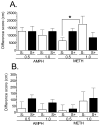A comparison of amphetamine- and methamphetamine-induced locomotor activity in rats: evidence for qualitative differences in behavior
- PMID: 17874316
- PMCID: PMC2423722
- DOI: 10.1007/s00213-007-0923-8
A comparison of amphetamine- and methamphetamine-induced locomotor activity in rats: evidence for qualitative differences in behavior
Abstract
Rationale: Methamphetamine (METH) is typically characterized as a more potent psychostimulant than amphetamine (AMPH), but few studies have directly compared the effects of these drugs at low, behaviorally activating doses that tend not to produce focused stereotypy.
Objectives: The objective of the study was to compare the effects of AMPH or METH treatment on locomotor activity in an open-field arena, focusing on their ability to produce conditioned locomotor activity, sensitization, and cross-sensitization.
Materials and methods: Adult male rats were given AMPH or METH (0.5 or 1.0 mg/kg) for 5 days, with half of the rats presented with discrete, salient stimuli (S+) during the postinjection period. After a 3-day withdrawal, they were given three different injections on successive days: a saline challenge to assess conditioned responding, a drug challenge to assess sensitization, and a cross-sensitization test to the same dose of the drug with which they were not pretreated.
Results: Except in certain conditions, AMPH and METH were equipotent at activating locomotor activity. The exceptions included when rats were presented with S+ on acute and drug challenge days and in tests of cross-sensitization. There were no consistent differences in the magnitude of sensitization produced by AMPH or METH, and both drugs produced similar amounts of conditioned locomotion after a saline injection.
Conclusions: We have found specific conditions where METH is more potent than AMPH, but this study and others that used higher doses of these drugs are not consistent with the generalized characterization of METH as a more potent psychostimulant.
Figures




Similar articles
-
Neurochemical and behavioral differences between d-methamphetamine and d-amphetamine in rats.Psychopharmacology (Berl). 2003 Feb;165(4):359-69. doi: 10.1007/s00213-002-1288-7. Epub 2002 Dec 19. Psychopharmacology (Berl). 2003. PMID: 12491026
-
Differences between d-methamphetamine and d-amphetamine in rats: working memory, tolerance, and extinction.Psychopharmacology (Berl). 2003 Nov;170(2):150-6. doi: 10.1007/s00213-003-1522-y. Epub 2003 May 28. Psychopharmacology (Berl). 2003. PMID: 12774190
-
Dissociation between long-lasting behavioral sensitization to amphetamine and impulsive choice in rats performing a delay-discounting task.Psychopharmacology (Berl). 2008 Sep;199(4):539-48. doi: 10.1007/s00213-008-1182-z. Epub 2008 May 13. Psychopharmacology (Berl). 2008. PMID: 18473112 Free PMC article.
-
Interactions between iboga agents and methamphetamine sensitization: studies of locomotion and stereotypy in rats.Psychopharmacology (Berl). 2000 Aug;151(2-3):234-41. doi: 10.1007/s002130000478. Psychopharmacology (Berl). 2000. PMID: 10972470
-
mu-Opioid receptor knockout mice are insensitive to methamphetamine-induced behavioral sensitization.J Neurosci Res. 2010 Aug 1;88(10):2294-302. doi: 10.1002/jnr.22386. J Neurosci Res. 2010. PMID: 20209629 Free PMC article.
Cited by
-
Developmental exposure to polychlorinated biphenyls reduces amphetamine behavioral sensitization in Long-Evans rats.Neurotoxicol Teratol. 2013 Jul-Aug;38:6-12. doi: 10.1016/j.ntt.2013.04.005. Epub 2013 Apr 23. Neurotoxicol Teratol. 2013. PMID: 23623962 Free PMC article.
-
Methamphetamine induces low levels of neurogenesis in striatal neuron subpopulations and differential motor performance.Neurotox Res. 2014 Aug;26(2):115-29. doi: 10.1007/s12640-014-9456-1. Epub 2014 Feb 19. Neurotox Res. 2014. PMID: 24549503 Free PMC article.
-
Amphetamine in adolescence disrupts the development of medial prefrontal cortex dopamine connectivity in a DCC-dependent manner.Neuropsychopharmacology. 2015 Mar 13;40(5):1101-12. doi: 10.1038/npp.2014.287. Neuropsychopharmacology. 2015. PMID: 25336209 Free PMC article.
-
Prenatal lead exposure enhances methamphetamine sensitization in rats.Pharmacol Biochem Behav. 2009 Aug;93(2):165-9. doi: 10.1016/j.pbb.2009.05.001. Epub 2009 May 9. Pharmacol Biochem Behav. 2009. PMID: 19433104 Free PMC article.
-
Ghrelin Receptor Antagonism of Methamphetamine-Induced Conditioned Place Preference and Intravenous Self-Administration in Rats.Int J Mol Sci. 2018 Sep 26;19(10):2925. doi: 10.3390/ijms19102925. Int J Mol Sci. 2018. PMID: 30261633 Free PMC article.
References
-
- Archer J. Tests for emotionality in rats and mice: a review. Anim Behav. 1973;21:205–235. - PubMed
-
- Badiani A, Robinson TE. Drug-induced neurobehavioral plasticity: the role of plasticity. Behav Pharm. 2004;15:327–339. - PubMed
-
- Balster RL, Schuster CR. A comparison of d-amphetamine, l-amphetamine, and methamphetamine self-administration in rhesus monkeys. Pharmacol Biochem Behav. 1973;1:67–71. - PubMed
-
- Bevins RA, Peterson JL. Individual differences in rats’ reactivity to novelty and the unconditioned and conditioned locomotor effects of methamphetamine. Pharmacol Biochem Behav. 2004;79:65–74. - PubMed
-
- Bevins RA, Klebaur JE, Bardo MT. Individual differences in response to novelty, amphetamine-induced activity and drug discrimination in rats. Behav Pharm. 1997;8:113–123. - PubMed
Publication types
MeSH terms
Substances
Grants and funding
LinkOut - more resources
Full Text Sources
Medical

